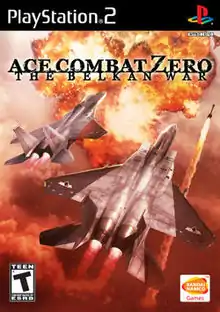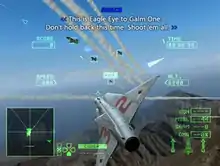Ace Combat Zero: The Belkan War
Ace Combat Zero: The Belkan War[lower-alpha 1] is a 2006 combat flight simulation video game developed and originally published by Namco for the PlayStation 2 video game console. The game was first released outside of Japan by the newly-formed Namco Bandai Games. Ace Combat Zero: The Belkan War is a combat flight simulation game but it is presented in a more arcade-like format in contrast to other flight-sim games arcade-style. It is part of the Ace Combat series of games. In Europe the game was released under the title Ace Combat: The Belkan War.
| Ace Combat Zero: The Belkan War | |
|---|---|
 | |
| Developer(s) | Namco |
| Publisher(s) |
|
| Director(s) | Naoto Maeda |
| Producer(s) | Hiroyuki Ichiyanagi |
| Designer(s) | Ryosuke Waki |
| Programmer(s) | Hiroki Odagaki Yoichi Murakoshi |
| Composer(s) | Keiki Kobayashi Tetsukazu Nakanishi Hiroshi Okubo Junichi Nakatsuru |
| Series | Ace Combat |
| Platform(s) | PlayStation 2 |
| Release | |
| Genre(s) | Air combat simulation |
| Mode(s) | Single-player, multiplayer |
Gameplay

Ace Combat Zero's gameplay is split into a single-player campaign mode and a two-player versus mode. The mechanics themselves are a mix of features from Ace Combat 04 and 5.
The game features primarily older versions of fighter aircraft seen in its predecessor game, such as the F-15C, F/A-18C, and several second- and third-generation fighters like the Saab 35 Draken. The player begins the game with an F-5E, an F-1, and a J35J, but is able to unlock and purchase more advanced aircraft by completing missions and destroying targets to earn credits. The game introduces the ADFX-01 Morgan superfighter (resembling the cancelled PZL-230 Skorpion attack aircraft), but players can also access the ADF-01 FALKEN from Ace Combat 2 and the X-02 Wyvern from Ace Combat 04.
The game revives Ace Combat 04's aircraft customization system - players can buy up to three special "SP" weapons per plane but can only choose one for the mission; they can also pick their wingman's SP weapon but not their plane. Another returning feature from Ace Combat 04 is the ability to withdraw from the battlefield for rearming at home base during long missions.
Zero retains Ace Combat 5's wingman-command system. During most campaign missions, the player can issue orders to the AI wingman using the DualShock controller's directional pad.
The game continues the Ace Combat series tradition of taking on aces who fly aircraft with unique paint schemes. Aside from the pilots and their squadrons whom the player faces as boss characters, many missions will have other enemy aces scattered throughout the game map; defeating them will list their unique plane and short pilot biographies in an in-game digital album.
Ace Style
One element of the game's mechanics is the Ace Style system. Over the course of the campaign, the player will encounter enemy targets that are incapable of fighting against the player and neutral entities, both of which are marked as yellow dots in the map display and yellow crossed target icons in the HUD. A horizontal bar with three boxes marked "Mercenary", "Soldier" and "Knight" can be found at the mission debriefing screen. The player's conduct during missions will see the rank slider bar sway toward one of these three boxes.
Which type of ace the player is will determine radio chatter, which ace squadrons the player encounters, as well as what FMVs play. Different aces earn different planes, and at the end of the game, each plane acquired will carry color schemes representing each fighting style.
- Mercenary Ace - Mercenary aces are pilots who destroy the opposition without mercy and are not concerned about their own allies, as announced by in-game FMVs. Players who kill all targets including non-hostile targets in a mission and ignore allied support requests, will see their ranking bar go left.
- Soldier Ace - Soldier aces are pilots who can fight as circumstances permit and change the flow of battle, as announced by in-game FMVs. This ranking is achieved by balancing kills of non-hostile targets while sparing some, and accepting some requests for support.
- Knight Ace - Knight aces are pilots who believe in fighting fair during the battle and protecting the weak, as announced by in-game FMVs. Players can attain this ranking by coming to the aid of allied units and not destroying non-hostile targets, which will result in the slider bar going right.
Plot
The plot of the game is told via a frame story, being a historical documentary covering the events of the "Belkan War" which ended a few years before its publication. The author of the documentary, a journalist named Brett Thompson, recounts how he discovered several allusions to an unidentified mercenary, whose actions played a pivotal role in the war's outcome. Thompson resolves to trace the mercenary's activities throughout the war, hoping to uncover his identity.
In March 1995, the Federation of Belka invades the Republic of Ustio, a former Belkan province, in an attempt to seize newly discovered natural resources required for Belka's economy. With much of Ustio rapidly fallen under Belkan occupation, the Ustian government allies with Osea, Sapin, and Yuktobania to fight off the advancing Belkans from their territories as the Allied Forces. Part of Ustio's war effort includes hiring mercenary pilots for their air force, including two pilots with callsigns "Cipher" and "Pixy", which are the 2 main characters of the game.
Cipher and Pixy work with Allied combat units in driving the Belkans from Ustio, allowing the Allies to go on the offensive and begin pushing deep into Belka with the aim of crushing its warfighting capabilities; Cipher distinguishes himself after destroying a massive Belkan tactical laser installation named "Excalibur," but Pixy starts to question the validity of the offensive, especially after an incident in which the Belkan city of Hoffnung is indiscriminately bombed by Allied forces. In response to the Allied advance, the Belkans detonate seven nuclear weapons on their own soil, killing tens of thousands and shocking the Allied Forces into temporarily halting combat operations. In the confusion of the nuclear blasts, Pixy fires upon Cipher's aircraft and deserts. After withdrawing, Cipher is paired up with PJ as his new wingman.
In the aftermath of the detonations, the Allies call for Belka's surrender; the Belkan interim government accepts the terms, reducing the size of the remaining Belkan military and partitioning much of Belka's resource-rich territory among the Allied countries. As the Allies argue over the newly gained territory, pilots and soldiers from all five nations show their resentment by forming a terrorist organization called A World With No Boundaries (AWWNB), that seeks to erase the concept of borders between countries and create a unified world.
Cipher and PJ deploy on several missions to suppress AWWNB, destroying the Belkan XB-0 Hresvelgr air fortress serving as AWWNB's mobile base, but it is discovered that AWWNB has taken over Avalon Dam, a Belkan ICBM installation containing a massive nuclear superweapon codenamed V2; AWWNB plans to use the weapon to force global unification. During the battle, Pixy, who had defected to AWWNB, attacks and shoots down PJ in a prototype fighter, and forces the V2's launch, challenging Cipher to a final aerial duel. Cipher battles Pixy and shoots him down, self-destructing the V2 and ending AWWNB's threat.
Throughout the game, Thompson's documentary plays between missions. Many of the enemy aces Cipher fought managed to eject from their planes and survive the war, and Thompson interviews each one about their battles with Cipher from their own perspectives. The final interviewee, Pixy, states that while he survived his dogfight with Cipher, he grew disillusioned with his AWWNB ideals, but continues to try to find meaning in them wherever he goes. He also thanks Cipher, in hopes that he may be watching the interview. The narrator concludes that while there's not enough information to truly uncover Cipher's identity, the fact that all of Cipher's former enemies smile when they recall him is enough for him, stating "that, perhaps, may be my answer".
Reception
| Aggregator | Score |
|---|---|
| Metacritic | 75/100[1] |
| Publication | Score |
|---|---|
| CVG | 8/10[2] |
| Eurogamer | 6/10[3] |
| Famitsu | 35/40[4] |
| GameSpot | 7.9/10[5] |
| IGN | 8.8/10[6] |
| Publication | Award |
|---|---|
| Famitsu | Platinum Hall of Fame[4] |
The game received positive reviews. It holds a 75/100 score on Metacritic.[1] As of January 2008, it has shipped 792,000 copies worldwide.[7] IGN's Juan Castro graded the game at 8.8/10, stating that Namco took a chance in slowly evolving the series, and it offers "slight modifications" into the engine." He also took note of the story as different from other console flight games and the cooperative mode is a blessing to fans.[6]
Computerandvideogames.com lauded the game's release date as a refresher from the multiple games of different genres that came out at the time. He noted the good graphical presentations and the sheer difficulty provided by the Aces.[2]
Eurogamer's Rob Fahey, however, said the game's "incremental" changes confuse players with what has changed between this and Unsung War.[3]
References
- "Ace Combat Zero: The Belkan War for PlayStation 2 Reviews". Metacritic. CBS Interactive. Archived from the original on August 4, 2020. Retrieved November 12, 2020.
- "Ace Combat Zero: The Belkan War review". Computer + Video Games. Future plc. May 30, 2006. Archived from the original on December 1, 2014. Retrieved November 12, 2020.
- Fahey, Rob (September 5, 2005). "Ace Combat Zero: The Belkan War". Eurogamer. Gamer Network. Archived from the original on October 24, 2020. Retrieved November 12, 2020.
- "エースコンバット・ゼロ ザ・ベルカン・ウォー (PS2)". Famitsu (in Japanese). Kadokawa Corporation. Archived from the original on August 22, 2014. Retrieved December 23, 2020.
- Kasavin, Greg (April 25, 2006). "Ace Combat Zero: The Belkan War for PlayStation 2 Review". GameSpot. CBS Interactive. Archived from the original on April 30, 2006. Retrieved November 12, 2020.
- Castro, Juan (April 21, 2006). "Ace Combat Zero: The Belkan War". IGN. Archived from the original on May 6, 2019. Retrieved November 12, 2020.
- Ichinoya, Hiroyuki (January 30, 2008). ""『エースコンバット』シリーズ全世界累計1,000万本突破!"". Ace Combat Web (in Japanese). Namco Bandai Games. Archived from the original on March 11, 2020. Retrieved January 25, 2021.